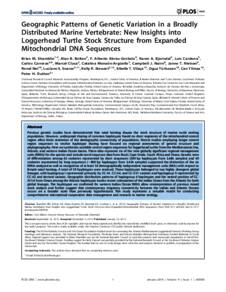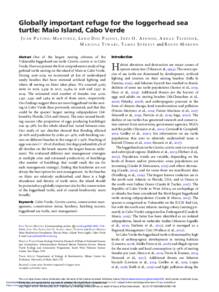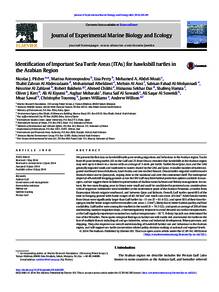Document
Geographic patterns of genetic variation in a broadly distributed marine vertebrate: new insights into loggerhead turtle stock structure from expanded mitochondrial DNA sequences.
Identifier
DOI: 10.1371/journal.pone.0085956
Contributors
Bolten, Alan B., Author
Abreu-Grobois, F. Alberto., Author
Bjorndal, Karen A., Author
Cardona, Luis., Author
Carreras, Carlos., Author
Clusa, Marcel., Author
Monzon-Arguello, Catalina., Author
Nairn, Campbell J., Author
Nielsen, Janne T., Author
Nel, Ronel., Author
Soares, Luciano S., Author
Stewart, Kelly R., Author
Vilaca, Sibelle T., Author
Turkozan, Oguz., Author
Yilmaz, Can., Author
Dutton, Peter H., Author
Publisher
Public Library of Science.
Gregorian
2014-01
Language
English
English abstract
Previous genetic studies have demonstrated that natal homing shapes the stock structure of marine turtle nesting populations. However, widespread sharing of common haplotypes based on short segments of the mitochondrial control region often limits resolution of the demographic connectivity of populations. Recent studies employing longer control region sequences to resolve haplotype sharing have focused on regional assessments of genetic structure and phylogeography. Here we synthesize available control region sequences for loggerhead turtles from the Mediterranean Sea, Atlantic, and western Indian Ocean basins. These data represent six of the nine globally significant regional management units (RMUs) for the species and include novel sequence data from Brazil, Cape Verde, South Africa and Oman. Genetic tests of differentiation among 42 rookeries represented by short sequences (380 bp haplotypes from 3,486 samples) and 40 rookeries represented by long sequences (∼800 bp haplotypes from 3,434 samples) supported the distinction of the six RMUs analyzed as well as recognition of at least 18 demographically independent management units (MUs) with respect to female natal homing. A total of 59 haplotypes were resolved. These haplotypes belonged to two highly divergent global lineages, with haplogroup I represented primarily by CC-A1, CC-A4, and CC-A11 variants and haplogroup II represented by CC-A2 and derived variants. Geographic distribution patterns of haplogroup II haplotypes and the nested position of CC-A11.6 from Oman among the Atlantic haplotypes invoke recent colonization of the Indian Ocean from the Atlantic for both global lineages. The haplotypes we confirmed for western Indian Ocean RMUs allow reinterpretation of previous mixed stock analysis and further suggest that contemporary migratory connectivity between the Indian and Atlantic Oceans occurs on a broader scale than previously hypothesized. This study represents a valuable model for conducting comprehensive international cooperative data management and research in marine ecology.
Member of
ISSN
1932-6203
Resource URL
Category
Journal articles



